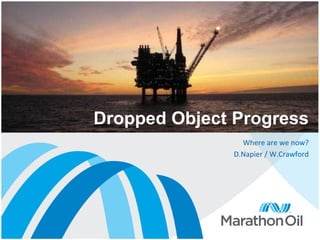
Dropped Object Progress in Brae Facilities
- 1. Where are we now? D.Napier / W.Crawford Dropped Object Progress
- 2. Background to DROPS programme Brae organisation was developing a heightened awareness to DROPS risk through Incident and Near Miss report patterns. HSE during audits had challenged Marathon to consider how they manage dropped objects. Information from within Marathon Oil and out with the organisation were showing that dropped objects were increasing in frequency. It was identified that DROPS was not purely a Drilling and Drilling Derrick issue, but had a much wider context to be considered. 2
- 3. Overarching Document (SOP 715) In order to define clear expectations regarding DROPS Management key document SOP 715 Dropped Object Management has been put in place. Purpose of the document was to outline the key areas where MOUK would set clear expectations in DROPS Management. The document is configured in 3 elements; Pro active Measures – checks, training and guidelines we can adopt to help prevent creating DROPS Dynamic Measures – processes or expectations that are defined to control activities where there are known to be DROPS potential Static Measures – Standards and checks that are part or our inspection regimes to consider the potential from DROPS and other areas 3
- 5. Proactive Controls Module safety audit Module audits enhanced with clear structure DROPS added as a specific consideration Driven in in SAP as a maintenance function to ensure formal process in place and history collected DROPS Training and hazard hunts 20 persons from across the Brae work force had TTT from the DROPS group Over 550 people in Brae been involved in cascade training from these people Approaching 700 potential dropped objects identified and removed or made safe for removal by specialised access at a later date across Brae facilities Pre Task Assessments Q4 upgrade process engaging in upgrading DROPS considerations Working on elevated platforms SOP provides guidance on temporary elevated areas (scaffolds) And guidance on fixed structures HES Expectations Clear DROPS expectations defined for all in this booklet which is issued to all personnel. 5
- 6. Dynamic Controls Working at Height – specific expectations in the following; Abseiling Scaffolding Rigging Lifting Checks outline for Shore base role To and from supply boat – deck crew tagging loads before moving Around platform Deck - checks in place to minimise DROPS Cranes Daily checks Routine Maintenance Projects Maintenance Q4 control process where equipment lifted 6
- 7. Static Controls Integrity Specific rejection criteria defined within integrity inspection work Adhoc reporting embraced within Integrity scope NEXUS tracking system in place for flagging and tracking Facilities Engineering Defined specifications in place for material type, bolted connections TMR process with a written scheme of examination Reliability Primary scope of Reliability team focus is built around the idea that effective condition based monitoring reduces breakdown maintenance and reduces needs for equipment maintenance and numerous DROPS issues 7
- 8. How well are we doing? DROP teams have done an excellent job of engaging in a wide cross section of the offshore team to identify all types of potential drops and completed a huge number of hazards hunts Module Inspections are in place for all 3 platforms and being driven from SAP and managed within the Planning and Maintenance teams. Best Practice taken from Supply Chain for transportation kit checklist adopted offshore MOUK fully engaged with DROPS forums for Industry sharing Significant number of Good Catches raised re. DROPS Overall DROPS focus in Braes at a very high level and showing positive results 8
- 9. What Do We Do Next? Platform Managers take responsibility for managing DROP’s on their facilities, providing support to platform DROP’s teams Manage platform DROP’s lists appropriately Carry out regular checks to ensure we are doing what we should be – PFM being generated for each platform Continued focus on potential risks from dropped objects Training – continue to provide training for new to Brae personnel in dropped object awareness 9
- 10. Any questions 10